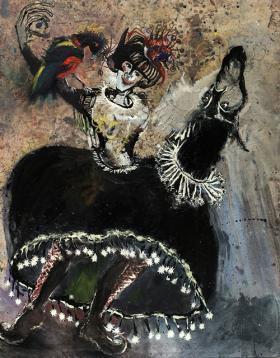Emmanuelle Renard, "À sauts et à gambades" (Skipping and jumping)
The set of paintings and drawings presented in Emmanuelle Renard's third personal exhibition at the gallery Polad-Hardouin is articulated around her great painting Après la pluie (“After the rain”, 2013), a second version of her free remake of Fragonard's L'escarpolette (“The Swing”), and part of her series Héroïque fantaisie from 2012.
From one remake to the next, the format stretches out, the sky becomes clearer, light becomes white and soft, as if shifting between two moments: Winter against Fall. A necrophagous Fall piles up all kinds of bodies, locking up space and making air stifling, whereas Winter, calm and frozen, represents the threshold of a new beginning, ready to welcome light and Spring. The versions contrast and follow each other smoothly. The swing is now floating, flaunting physical laws, in a temporary balance. In this last version, the young woman's expression is relaxed, altruistic and smiling: an atmosphere that anticipates the works presented here.
In this new series, compositions become lighter and clashing. Canvases are left raw on most of their surface, and landscapes become airy. The living are suspended out of time and space, as when Emmanuelle Renard creates her works. Her characters, free from worldly contingencies, project themselves onto the environments they have themselves generated and mastered.
Emmanuelle Renard works on the loss of landmarks and chooses to express the blind part, this “(...) connecting darkness where the basis of experience and indeed of the world and of this universe of sense through which we perceive it, are indicated"(1).
Perturbing cosmic order to turn the world into a playground. She works directly on the floor of her workshop, simultaneously developing a set of paintings and one of drawings, moving between the two, from an automatic drawing to the next, from a drawing to a painting, without any hierarchy. She builds by steps, in a constant back and forth, through a multiplication of tracks and echoes between compositions.
She uses all kinds of processes to get out of familiar territories, e.g. by practicing remakes, or by working simultaneously on a set of works – paintings or drawings – as if playing a solitary game of cadavre exquis.
Backwards, randomly, she comes back to one, moves on to another, “à sauts et gambades,” skipping and jumping. Emmanuelle Renard frees herself from obstacles to turn them into springboards, visionary projections mixing phantasms and memories.
The artist creates distortions by setting side by side heteroclite elements that merrily co-habit. Superheroes' masks mix with medieval garments (ruffs, hobby-horses). Circassian elements, supported by chimeras, loom over urban landscapes, uproot lonely characters, pull and waylay cars. Scales are out of kilter, cities move away and humans acquire their full importance in a festive poetry.
In the marked interplay of hollow and full parts, dense and opaque garments heavy with paint, also seem to concretize heaviness while limbs and faces are set in a cosmic landscape.
Emmanuelle Renard wisely discards habits; she offers us a superb exhibition where she shares her last meanderings into the most secret and unfathomable parts of corporality. Let us quote Montaigne, whose taste for traveling she shares:
I go out of my way; but 'tis rather by licence than oversight (2)
(1)- Jean-luc lannoy, langage,perception,mouvement: blanchot et Merleau-ponty, éditions Jérôme Millon, Grenoble, 2008
(2)- Montaigne, Essays; (III,9) "Of Vanity", transl charles cotton
